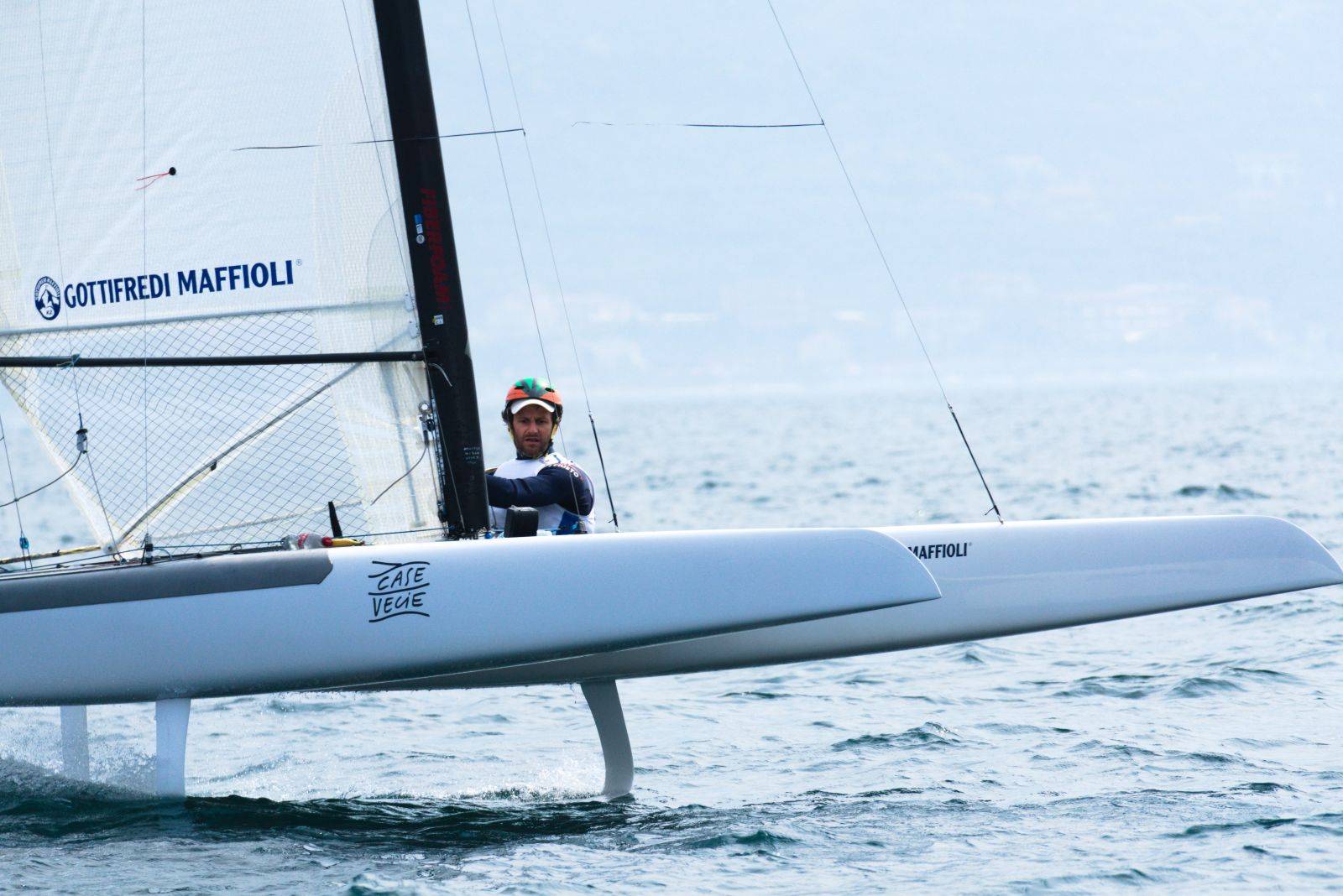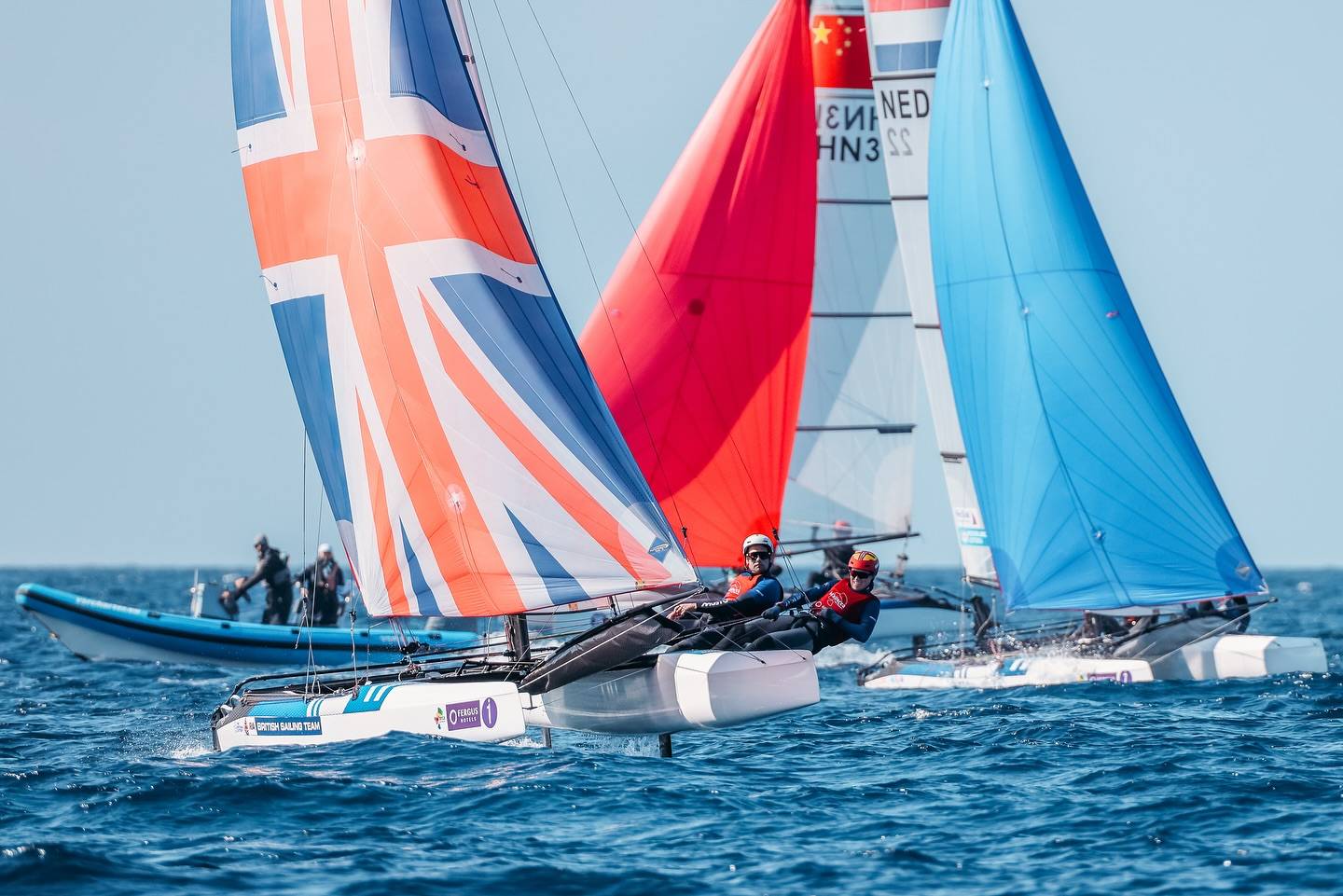A-Cat Europeans 2022: Classic Fleet report by Christian Stock


Excellent detailed Report from the Classic fleet sent by Christian Stock. Read to get data on the conditions,, equipment and more.
Photos: Gordon Upton Photography, Christian Stock (GER 100) leading a Classic fleet start and sailing his Nikita + Landy Classic cut. He finished in 13th overall in the Classic discipline.
European Championship 2022 in Arco/ Lake Garda – from a Classic’s Perspective
(by Christian Stock)
European Championship of the A-Cats in Arco, at the northern end of Lake Garda, where there is always a reliable strong wind? What a sailing dream! The A-Cat Classic sailor’s heart leaps for joy, and registering after qualifying at national level is a mere formality. But the heart beats not only with joy. There are also stories of merciless strong wind regattas, of thunderstorms with destroyed catamarans and much more. Should one really do this to oneself? 30 Classic sailors from eleven countries decided for themselves: Yes!
In the end, both forms of heart palpitations proved to be justified. During the training days there was as always strong wind with decent waves, but it was absolutely sailable. Especially in the sailing area towards the south, around Navene, the wind usually dropped to 12 to 15 knots. An A-Cat doesn’t really need more than that to go full speed. How good that the planned racecourse “Verona” was located exactly here. Unfortunately it was never to be used, one of several puzzling decisions of the race committee.
But let’s start from the beginning. Already in Sunday’s practice race the 20-year-old youngster Moritz Weis showed in perfect sailing conditions that it is possible to learn to sail even on a small southern German inland lake like the Schluchsee. He convinced especially on the downwind courses with excellent boat speed and could even compensate for overly cautious starts. Sovereignly he went barefoot on the downwind into the trapeze and overtook one competitor after the other. Also right at the front, as expected, was “Mr. Fiberfoam”, Scott Anderson from Australia. His decades of experience, including as silver medalist in the 1984 Tornado, paid off once again. Gustavo Doreste from Barcelona, also an old hand in the A-Cat, was also up to the challenge. Other favorites included “Mr. Pink Hammer” Micky Todd, the reigning runner-up World Champion in the A-Cat Classic, the Italian-Swedish strong-wind king Alberto Farmesi and the wind-resistant Scot Hugh MacGregor.
But the Classic fleet had many more good sailors to show, as was evident in the first days of racing. The finishes were close, even in the rear midfield hard duels relaxed, in which every meter was fought for. A briefly mediocre sail trim, a slightly screwed up tack or a layline that was not hit optimally, and you were immediately moved back at least five places, often even ten. This made the races highly exciting, which was a good thing, because tactically the north of Lake Garda has very little to offer. On the northern “Trento” course, the race is almost always held on the right-hand side of the track. There, the towering rocks accelerate the wind by about three knots and also provide a lift to the windward mark. On the downwind it is very similar, at the run-off buoy all sailors jibe as fast as possible over to the wall.
After two days of racing in fantastic conditions, Moritz was just in first place, followed by Scotty and Gustavo. But then followed two days of racing that made even the most hardened sailors break out in a cold sweat, as they all admitted themselves, and that shook up the ranking. On Wednesday, the wind did not pick up to 20 to 25 knots until the starting signal; it is halfway understandable that the race committee allowed this race to run, even if real racing with an A-Cat was actually out of the question and all sailors only sailed for safety. Micky Todd nevertheless pitchpoled on the downwind course and injured his arm on the sharp trailing edge of the centerboard. He spent the night in the hospital where he needed stitches. It could have been even worse, the weather forecast had predicted winds of up to 35 knots for the early evening due to a front.
On Thursday it actually got worse. The Foilers were again the first to start in initially moderate conditions. But then the wind swelled so powerfully off Torbole that even the surfers only used their 4m² sails and were still often catapulted into the water. Regardless of this, the race committee called for a flag signal to set sail. The Classic fleet hesitated united until it was suddenly said that there were only 15 knots on the regatta course (whereby this measurement was obviously made as always with a hand-held anemometer while sitting in front of the cabin of the motorboat, so it was not exactly meaningful). Ten sailors, most of them weighing over 95 kg, fought their way onto the course, five others abandoned the attempt because they couldn’t even tack in the meanwhile raging witch’s cauldron off Torbole. The sensible ones had long since decided not to take part in this madness, including the leading Moritz Weis.
The race committee nevertheless started two races, of which Scott Anderson said afterwards that they had been “well over class limit”. He came ashore as white as a sheet and, like all the sailors, was glad that there was only one broken mast and one broken boom, but no injuries. Scotty had tried on the water to get the race committee and the jury to cancel the races, but did not succeed. As a fair sportsman, it was very regrettable for him that the championship was decided in this way, he would have preferred to win it in real conditions against all sailors, not by a test of courage à la Survival of the Fittest.
Friday then reconciled again somewhat. The Classics were finally allowed to get on the water first and were able to sail two races in beautiful conditions. Moritz Weis won both races and secured third place in the overall standings. The deserved winner of the regatta was Scott Anderson. He was not only fast but also tactically the best. The Spaniard Gustovo Doreste became European Champion just as deservedly due to his second place. Chapeau!
The European Championship was also exciting from a technical point of view. A good dozen sailors successfully competed with current Exploder AD3 platforms and with comparable Scheurer G6 platforms, with centerboard adjustment, large non-adjustable rudder foils and flat-cut Decksweeper sails with small tops. These platforms differed only by detail, such as whether they had a rigid or non-rigid trampoline. It turned out that anything that makes foilers fast also speeds up Classics. As soon as the wind speed exceeds 12 knots, the AD3 and G6 can reach speeds of around 13 knots upwind and just under 20 knots downwind. That’s a lot faster than previous conventional Classics. The fact that Scott Anderson won with a Nikita that was actually only advantageous in lighter winds was primarily due to his outstanding sailing experience. However, his boat also featured a flat decksweeper, rudder foils and daggerboard adjustment. One interesting detail about his boat is that he uses a straight main boom, and the sail is double-layered around the boom in a 49er style. The sail does dent a bit, but that doesn’t seem to cause any disadvantage. The gooseneck is attached at the very bottom of the mast, and the boom rises at an angle to the stern. The advantage is that if you convert from a conventional sail, you can keep your old boom and mainsheet system.
An Italian sailor competed with a brand new “Alien” mast from Bimare/ Petrucci. According to him, it is lighter than other manufacturers’ masts because it is baked at 120 degrees in an autoclave. The mast made a very good impression, but still has to prove itself in further practice. On the other hand, the sails of numerous different sailmakers have already proven themselves. There are now around ten manufacturers who deliver very good quality; a general difference in speed between their sails was not discernible.
Conclusion: The Euro on Lake Garda was a great adventure, which was mostly great fun and was only marred by a few bad decisions for the Classics by the race committee. A very special thanks goes to Rainer Bohrer, who prepared the Euro for more than two years and occasionally had to show a lot of patience and frustration tolerance, as well as Sylvia Gath from CV Arco, who was able to tame the demanding horde of A-Cat sailors at any time with her charm.
Next year, it’s off to the World Championships in Toulon on the Mediterranean. It will be openly advertised and could attract well over 50 Classics, as these are especially prevalent in France and Italy.
Christian Stock GER 100




























I just heard that my great sailing friend and former CEO of Hobiecat Europe has passed. May The endless oceans…
...Report was sent by an F18 Sailor, if you want Hobies reported send your own, we'll publish as usual. Cheers.
Looks like in your report the Hobies are not really present. Suggest to rewrite the article.
Thanks for the great report Wik. Great battle.
If I correctly read the results the overall winner this year is a Hobie16